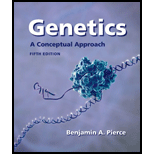
a.
To determine:
The probability that another child of the couple will have retinoblastoma.
Introduction:
Alfred Knudson in 1971, proposed a model to explain the genetic basis for cancer. He was studying retinoblastoma (develops in one eye but sometimes appears in both) and proposed that retinoblastoma results from separate genetic defects mainly two and both of which are required for the development of cancer. Mutations in the cells of a single eye results in “unilateral retinoblastoma” which is common and can occur to a normal person.
Mutations in the cells of both eyes result in “bilateral retinoblastoma” which is rare and cannot happen randomly like unilateral retinoblastoma. Individuals inherit the only single mutation from suffering relatives and if the second mutation occurs in any of these cells then it would result in bilateral retinoblastoma.
b.
To determine:
Whether the next child has unilateral or bilateral retinoblastoma.
Introduction:
Alfred Knudson in 1971, proposed a model to explain the genetic basis for cancer. He was studying retinoblastoma (develops in one eye but sometimes appears in both) and proposed that retinoblastoma results from separate genetic defects mainly two and both of which are required for the development of cancer. Mutations in the cells of a single eye results in “unilateral retinoblastoma” which is common and can occur to a normal person.
Mutations in the cells of both eyes result in “bilateral retinoblastoma” which is rare and cannot happen randomly like unilateral retinoblastoma. Individuals inherit the only single mutation from suffering relatives and if the second mutation occurs in any of these cells then it would result in bilateral retinoblastoma.
c.
To determine:
The reason corresponding to that father has unilateral retinoblastoma while in his son’s and brother’s case it is bilateral retinoblastoma.
Introduction:
Alfred Knudson in 1971, proposed a model to explain the genetic basis for cancer. He was studying retinoblastoma (develops in one eye but sometimes appears in both) and proposed that retinoblastoma results from separate genetic defects mainly two and both of which are required for the development of cancer. Mutations in the cells of a single eye results in “unilateral retinoblastoma” which is common and can occur to a normal person.
Mutations in the cells of both eyes result in “bilateral retinoblastoma” which is rare and cannot happen randomly like unilateral retinoblastoma. Individuals inherit the only single mutation from suffering relatives and if the second mutation occurs in any of these cells then it would result in bilateral retinoblastoma.
Want to see the full answer?
Check out a sample textbook solution
Chapter 23 Solutions
Genetics
- ✓ Details Draw a protein that is embedded in a membrane (a transmembrane protein), label the lipid bilayer and the protein. Identify the areas of the lipid bilayer that are hydrophobic and hydrophilic. Draw a membrane with two transporters: a proton pump transporter that uses ATP to generate a proton gradient, and a second transporter that moves glucose by secondary active transport (cartoon-like is ok). It will be important to show protons moving in the correct direction, and that the transporter that is powered by secondary active transport is logically related to the proton pump.arrow_forwarddrawing chemical structure of ATP. please draw in and label whats asked. Thank you.arrow_forwardOutline the negative feedback loop that allows us to maintain a healthy water concentration in our blood. You may use diagram if you wisharrow_forward
- Give examples of fat soluble and non-fat soluble hormonesarrow_forwardJust click view full document and register so you can see the whole document. how do i access this. following from the previous question; https://www.bartleby.com/questions-and-answers/hi-hi-with-this-unit-assessment-psy4406-tp4-report-assessment-material-case-stydu-ms-alecia-moore.-o/5e09906a-5101-4297-a8f7-49449b0bb5a7. on Google this image comes up and i have signed/ payed for the service and unable to access the full document. are you able to copy and past to this response. please see the screenshot from google page. unfortunality its not allowing me attch the image can you please show me the mathmetic calculation/ workout for the reult sectionarrow_forwardIn tabular form, differentiate between reversible and irreversible cell injury.arrow_forward
- 1.)What cross will result in half homozygous dominant offspring and half heterozygous offspring? 2.) What cross will result in all heterozygous offspring?arrow_forward1.Steroids like testosterone and estrogen are nonpolar and large (~18 carbons). Steroids diffuse through membranes without transporters. Compare and contrast the remaining substances and circle the three substances that can diffuse through a membrane the fastest, without a transporter. Put a square around the other substance that can also diffuse through a membrane (1000x slower but also without a transporter). Molecule Steroid H+ CO₂ Glucose (C6H12O6) H₂O Na+ N₂ Size (Small/Big) Big Nonpolar/Polar/ Nonpolar lonizedarrow_forwardwhat are the answer from the bookarrow_forward
 Human Anatomy & Physiology (11th Edition)BiologyISBN:9780134580999Author:Elaine N. Marieb, Katja N. HoehnPublisher:PEARSON
Human Anatomy & Physiology (11th Edition)BiologyISBN:9780134580999Author:Elaine N. Marieb, Katja N. HoehnPublisher:PEARSON Biology 2eBiologyISBN:9781947172517Author:Matthew Douglas, Jung Choi, Mary Ann ClarkPublisher:OpenStax
Biology 2eBiologyISBN:9781947172517Author:Matthew Douglas, Jung Choi, Mary Ann ClarkPublisher:OpenStax Anatomy & PhysiologyBiologyISBN:9781259398629Author:McKinley, Michael P., O'loughlin, Valerie Dean, Bidle, Theresa StouterPublisher:Mcgraw Hill Education,
Anatomy & PhysiologyBiologyISBN:9781259398629Author:McKinley, Michael P., O'loughlin, Valerie Dean, Bidle, Theresa StouterPublisher:Mcgraw Hill Education, Molecular Biology of the Cell (Sixth Edition)BiologyISBN:9780815344322Author:Bruce Alberts, Alexander D. Johnson, Julian Lewis, David Morgan, Martin Raff, Keith Roberts, Peter WalterPublisher:W. W. Norton & Company
Molecular Biology of the Cell (Sixth Edition)BiologyISBN:9780815344322Author:Bruce Alberts, Alexander D. Johnson, Julian Lewis, David Morgan, Martin Raff, Keith Roberts, Peter WalterPublisher:W. W. Norton & Company Laboratory Manual For Human Anatomy & PhysiologyBiologyISBN:9781260159363Author:Martin, Terry R., Prentice-craver, CynthiaPublisher:McGraw-Hill Publishing Co.
Laboratory Manual For Human Anatomy & PhysiologyBiologyISBN:9781260159363Author:Martin, Terry R., Prentice-craver, CynthiaPublisher:McGraw-Hill Publishing Co. Inquiry Into Life (16th Edition)BiologyISBN:9781260231700Author:Sylvia S. Mader, Michael WindelspechtPublisher:McGraw Hill Education
Inquiry Into Life (16th Edition)BiologyISBN:9781260231700Author:Sylvia S. Mader, Michael WindelspechtPublisher:McGraw Hill Education





